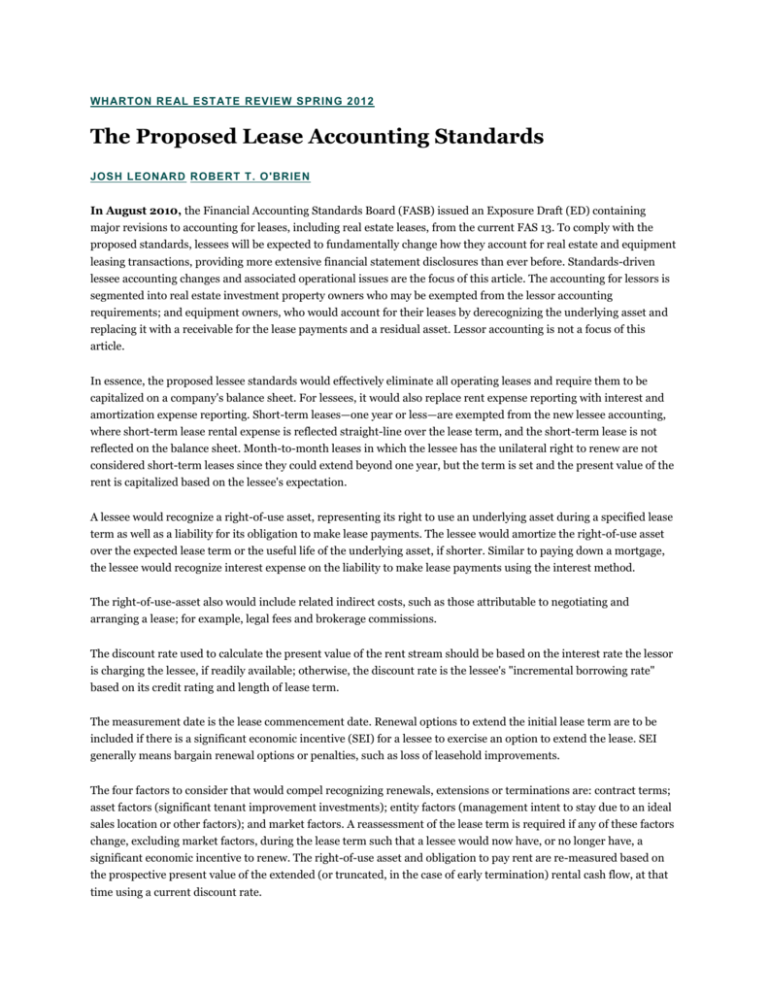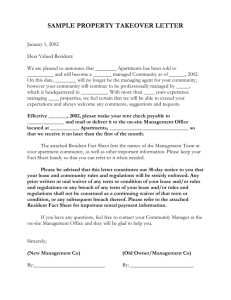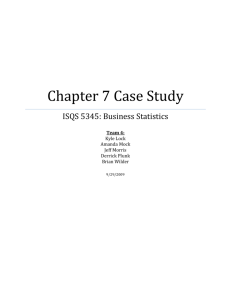
WHARTON REAL ESTATE REVIEW SPRING 2012
The Proposed Lease Accounting Standards
JOSH LEONARD ROBERT T. O'BRIEN
In August 2010, the Financial Accounting Standards Board (FASB) issued an Exposure Draft (ED) containing
major revisions to accounting for leases, including real estate leases, from the current FAS 13. To comply with the
proposed standards, lessees will be expected to fundamentally change how they account for real estate and equipment
leasing transactions, providing more extensive financial statement disclosures than ever before. Standards-driven
lessee accounting changes and associated operational issues are the focus of this article. The accounting for lessors is
segmented into real estate investment property owners who may be exempted from the lessor accounting
requirements; and equipment owners, who would account for their leases by derecognizing the underlying asset and
replacing it with a receivable for the lease payments and a residual asset. Lessor accounting is not a focus of this
article.
In essence, the proposed lessee standards would effectively eliminate all operating leases and require them to be
capitalized on a company's balance sheet. For lessees, it would also replace rent expense reporting with interest and
amortization expense reporting. Short-term leases—one year or less—are exempted from the new lessee accounting,
where short-term lease rental expense is reflected straight-line over the lease term, and the short-term lease is not
reflected on the balance sheet. Month-to-month leases in which the lessee has the unilateral right to renew are not
considered short-term leases since they could extend beyond one year, but the term is set and the present value of the
rent is capitalized based on the lessee's expectation.
A lessee would recognize a right-of-use asset, representing its right to use an underlying asset during a specified lease
term as well as a liability for its obligation to make lease payments. The lessee would amortize the right-of-use asset
over the expected lease term or the useful life of the underlying asset, if shorter. Similar to paying down a mortgage,
the lessee would recognize interest expense on the liability to make lease payments using the interest method.
The right-of-use-asset also would include related indirect costs, such as those attributable to negotiating and
arranging a lease; for example, legal fees and brokerage commissions.
The discount rate used to calculate the present value of the rent stream should be based on the interest rate the lessor
is charging the lessee, if readily available; otherwise, the discount rate is the lessee's "incremental borrowing rate"
based on its credit rating and length of lease term.
The measurement date is the lease commencement date. Renewal options to extend the initial lease term are to be
included if there is a significant economic incentive (SEI) for a lessee to exercise an option to extend the lease. SEI
generally means bargain renewal options or penalties, such as loss of leasehold improvements.
The four factors to consider that would compel recognizing renewals, extensions or terminations are: contract terms;
asset factors (significant tenant improvement investments); entity factors (management intent to stay due to an ideal
sales location or other factors); and market factors. A reassessment of the lease term is required if any of these factors
change, excluding market factors, during the lease term such that a lessee would now have, or no longer have, a
significant economic incentive to renew. The right-of-use asset and obligation to pay rent are re-measured based on
the prospective present value of the extended (or truncated, in the case of early termination) rental cash flow, at that
time using a current discount rate.
Figure 1 illustrates total lease expense pattern for a renewal reassessment versus recognizing the renewal extension at
the time of the initial lease term. The example assumes an initial ten-year lease term with a five-year renewal option.
The entity incurs significant leasehold improvements in year six, which triggers a reassessment and a determination
that the renewal option would be exercised.
Figure 1: Lease expense under two conditions
© 2012 Deloitte Development LLC. All rights reserved.
Contingent payments based on consumer price index (CPI) increases will require a new accounting treatment based
on a spot-rate index such as the Bureau of Labor Statistics, resetting the right-of-use asset and obligation to pay rent
each time the contingent payment is adjusted during the lease term. Note that percentage rent payments, such as
those paid to lessors as a percentage of retail sales, will not be capitalized as initially considered in the ED. This
requirement was eliminated, in part, due to the negative feedback received by the boards.
A lessee will apply the lessor model for subleases, while master lease liability will remain intact. For gross leases
where the base rent includes some portion of operating expenses and property taxes (otherwise referred to as
executory costs), including fixed common area maintenance (CAM) for retail leases, these costs will not be capitalized
since they are considered period costs. These costs typically are easy to determine but can become complex when base
year (or stop) leases are involved, usually office-related; for example, where operating costs are imbedded in the total
gross rent paid to the landlord.
As noted earlier, the FASB, in concert with the International Accounting Standards Board (IASB), is expected to issue
the revised ED during first quarter 2012, with a 120-day comment period. The public is encouraged to comment on
the revised ED so that the FASB and IASB can consider all factors before finalizing the lease standard.
The FASB is targeting third quarter 2012 for issuing the final standard. If this timing holds, then an expected effective
date for the proposed standard of January 1, 2016, is not unreasonable. Of note for SEC registrants, but not for
private companies, the effective date for reflecting the capitalized leases may also require two years of retroactive
accounting of leases for reporting comparability under the proposed standard—back to January 1, 2014. There will no
grandfathering provisions, meaning that all existing leases at this time will need to be capitalized, even if they are in
mid-lease term.
For the transition period when they are calculating the opening balance sheet right-of-use asset and obligation to pay
rent amounts, lessees will have the option of applying a full retrospective approach to the implementation; that is, go
back to the beginning of the lease arrangement and apply the revised guidance going forward, or use a modified
retrospective approach that would attempt to simulate a full retrospective approach.
Because the proposed standard could have an immense impact on the balance sheets of companies that lease
commercial property—particularly those with large portfolios—lessees should begin planning now to address
necessary changes in collecting and validating core lease information, supporting business and accounting processes,
and integrating with new or upgraded technology systems. These, along with changes in affected financial statements
and real estate strategies, will play a critical role in the upcoming standards transformation.
Changes To Reporting
It is important to note several changes to financial statements that are associated with the proposed accounting
standards. Relative to the balance sheet, the lift in assets and liabilities may change certain financial ratios that were
previously stable. Specifically, debt to equity ratios will likely increase. Depending on an entity's existing debt
covenants, the increase in debt or numerator may prospectively trigger a technical default of a loan so early
renegotiations would be expected and prudent. We suspect that most creditors will provide waivers or modifications
to the impacted loan covenants, given that the change is a book accounting change, and not a real change in the cash
obligation. However, depending on the creditor-debtor relationship, this technical violation of financial ratio could be
used as a negotiating advantage. As for the profit and loss statement, due to the front-loading of interest early in the
lease life, net operating income (NOI) could initially decline, a condition that likely will reverse later in the portfolio's
life.
The financial metrics of earnings before interest, depreciation, and amortization (EBITA) are expected to
permanently increase (except for short-term lease rental expense), as long-term rent will now be reflected below as
interest and amortization. EBITA will increase, so internal and external metrics for management compensation,
contract terms, etc., may need to be re-evaluated. Consider, for example, certain internal metrics for plant managers
or retail store managers. If their compensation is based on NOI, which will be lower initially, especially when
compared to current accounting straight-line rent, there likely will be some year-end discussions about compensation
since this accounting change has little to do with the manager's performance. Those measured on EBITA will report
greater income than before.
Changes To Market Behavior
A Deloitte survey issued in early 2011 revealed several significant market reactions to the proposed accounting
changes. Forty-two percent of respondents indicated they will likely try to secure shorter-term leases, ostensibly to
reduce the liability side of their balance sheet. If the proposed accounting standards change market behavior, which is
not the accounting board's intent, then lessors will likely react by raising rent for shorter-term leases. This is not
unexpected, given that an owner is likely to experience higher turnover costs, such as tenant improvements,
brokerage commissions, and marketing costs, and not different than if a longer-term lease were in place to amortize
these costs. However, anecdotal information indicates that most companies will not change their lease structure.
In another survey finding, 28 percent of respondents said, due to the accounting changes, they would rather own than
lease real estate. Although many tenants may feel that 100 percent financing is compelling, some may prefer owning
to leasing, as there is an insignificant difference now on the balance sheet between leasing and owning. Although
leasing is an effective financing mechanism for tenants, some tenants may prefer to control the asset themselves. One
might speculate that the percentage of lessees that are anticipated to own equipment might be higher than this, as it is
a smaller ticket item than real estate.
Few companies adequately prepare for compliance and implementation challenges.
According to the Deloitte survey, more than 80 percent of respondents believe that the proposed FASB lease
accounting standard will place a significant burden on financial reporting for tenants as well as property owners. Yet
only 7 percent of executives believe their companies are well prepared to comply with the standard.
Compliance is expected to require a significant effort and an ongoing system of accounting rigor that currently does
not exist within many companies. Gathering lease data is the most important and onerous issue, followed by systems
integration challenges. Although compliance challenges are expected to vary by industry, retail, fast-food, oil and gas,
telecommunications, and other organizations with large lease portfolios should anticipate the need for significant
upgrades or acquisitions of new technology systems to capture the number of leases and their associated attributes.
For example, Deloitte estimates that more than 100 separate data elements are required to properly calculate the
balance sheet and income statement for a single retail lease.
Of note, since this is a global compliance effort, companies with decentralized leases should expect challenges when
trying to capture the necessary leases and lease information and put them on the balance sheet. This is particularly
true for equipment leases, which can be even more elusive than real estate leases due to their size and dollar value.
Changing CFO/CRE Relationship
As a company's lease management takes shape, Deloitte anticipates that it could lead to a closer alliance internally
between the organization's CFO and its corporate real estate (CRE) executives. Currently, their relationship typically
revolves around accounts payable-related issues. For example, during budget season the CFO might ask, "How much
will your real estate spend be next year?" or instruct the CRE team to "let me know when you veer off budget."
However, as a result of discussions about the proposed lease accounting standards with Deloitte's CRE clients and
contacts, we foresee a much stronger nexus between the CFO's accounting department, which is primarily responsible
for properly accounting for and implementing all FASB changes, and the real estate department, where historically
the essential real estate lease information resides, in order to properly calculate and convert the operating leases into
newly fashioned capital leases. Further, each time a lease occurs, rather than registering as merely a spike in rent
expense as in past years, the firm's balance sheet will be impacted.
The advent of Sarbanes-Oxley, which specifies that the CFO must personally sign off on the general veracity of
financial statements, also adds impetus to CFO/CRE executive collaboration because, going forward, their interaction
will focus more on real estate information. The changing accounting standards will likely generate heightened
scrutiny of real estate lease data such as key rents, dates and options, due to their increased significance to the
balance sheets under the CFO's charge. Typically, lease information is housed in a real estate department's standalone lease administration database. There may be an interface with the enterprise accounting system for rent
expense, but the vast majority of lease information is neither integrated with other accounting systems nor directly
overseen by the CFO. Going forward, the CFO likely will insist on knowing how accurate the lease information is, and
how it migrates into the company's databases. Also, while many real estate departments may fall under the auspices
of the CFO, they may also report to administration, human resources, or the general counsel's office—organizations
that are often removed from accounting. The need for a more integrated, collaborative CFO/CRE relationship is
expected to be a natural outgrowth of the proposed standard.
What Should You Be Doing Now?
Since the issuance date for the final standard has been pushed out to late 2012, some companies are saying "Let's wait
to address the proposed standards until we have a definitive date for compliance." However, while no one can predict
the ultimate outcome, the basic architecture of the lessee accounting is fundamentally set. There may be some minor
nuance adjustments, but the primary data requirements to calculate the capitalized leases are close to final.
Companies should start examining their lease portfolios now to compile adequate lease information and
identify/secure the necessary technology capabilities and personnel resources to implement and monitor the
proposed standards. It is anticipated that once the FASB issues the final standard, external resources—from software
vendors to implementers to lease abstracters—may be difficult to secure in numbers adequate to meet demand.
Companies with 300 or more leases in their portfolios are beginning to prepare their lease implementation roadmap,
an important planning tool. To assist these efforts, Deloitte has identified seven work streams in an illustrative
roadmap, which displays key milestone activities to arrive at a January 1, 2016, effective start date (Figure 2). The key
action steps include the following:
Figure 2: Illustrative Lease Implementation Roadmap, effective 20161
© 2012 Deloitte Development LLC. All rights reserved.
Program management/communications.Medium to large organizations should establish an internal management
team to coordinate cross-departmental activities to implement the lease accounting change. This team should include
a representative from the CFO's organization to oversee the real estate department's work, the gathering of disparate
equipment leases from around the company and the management of the remaining work streams.
Lease data collection.This is one of the most critical steps to achieving a successful transformation, as lease data is the
primary source of the balance sheet and P&L accounting adjustments and its accuracy and completeness is essential.
The collection effort can be divided into four tracks. Lease inventory: Are all real estate and equipment lease
contracts fully accounted for around the company, including long-term, short-term and month-to-month leases? This
is important, especially for global corporations with decentralized operating units that historically have executed and
maintained their own leases. The second track is data attributes. This track presents a two-part question: Are all the
necessary lease data attributes captured in a useable electronic format, and do some of the attributes need to be
abstracted or re-abstracted from the leases? If there are plans to abstract the leases, open up the query about which
data attributes to abstract, confirm, or validate to the accounting department as well as other operational lease
stakeholders who might use the lease information in a database system. Abstraction costs climb with a large number
of leases, so be careful when conducting this critical step. Only abstract those attributes that are truly "needed," not
"wanted," and, as noted earlier, touch the lease only once. Data formatting is a third track. Much of the necessary
lease data already resides in existing databases but may be formatted in an alpha field that cannot be easily processed
or calculated, such as a numeric field. For example, there may be significant lease renewal information that is
captured in an Excel field in a text format that needs to be broken-out into multiple numeric data fields to properly
process and calculate the lease term and prospective rent stream. Proper reformatting for certain critical data fields
can facilitate the information collection process. Finally, data integrity. This track goes to the heart of the CFO's
comfort level when using "someone else's" data for accounting purposes. If the data resides in the real estate
department, has the information been vetted adequately to assure its utilization for accounting purposes? This can
quickly be determined by testing or sampling, say, 3 percent to 10 percent of the lease population and revalidating the
lease information against that which is stored in the database. If the results come close to, say, an arbitrary 98+
percent accuracy level, then one can generally assume the balance of the database is representatively accurate as well.
A lesser number may not be so comforting.
Companies should establish a set of internal operating procedures and internal controls as well as designate
appropriate internal "owners" to facilitate ongoing compliance once the projected accounting standard is up and
running in 2016. For example, who will be the key parties responsible for providing quarterly and year-end reporting,
for gathering managerial and operational projections for renewal expectations, for "re-assessment" recalculations
based on renewal changes, for annual CPI recalculations, for lease abstraction procedures when new leases have
commenced, for segregating net from gross rental charges for new leases?
Implementing this work stream of the roadmap will be a substantial undertaking. Most existing lease or general
accounting software is not set up to calculate or convert capitalized leases from operating leases. Many real estate
software companies are developing new code to address the changes in advance of the final standard's release, and
will make adjustments as necessary. However, some of the major enterprise software companies are, understandably,
waiting for the final FASB issuance since changing their software is a very involved process. Whether they use a real
estate-specific or enterprise solution, many companies will need to upgrade or replace their existing lease accounting
software.
If a new software vendor needs to be selected, it may require a competitive process inclusive of an RFP and
demonstration comparisons to determine which candidate will best meet this important accounting need and the
company's operational needs. In addition, the company may want to consider developing implementation strategies,
including essential software training for the user group, to assure that the software vendor is properly integrating the
new technology with company processes and procedures necessary to execute the proposed accounting standards.
Companies should obtain guidance before, during and after transformation to make sure all accounting provisions are
being properly addressed, from lease abstraction to reporting procedures to systems software consistent with the
proposed standard. Depending on how a company's leases operate, the renewal or required reassessment calculations
may drive how much technical accounting input is needed.
Implementing the proposed lease accounting standards may require significant training updates, both for accounting
and software, and for the hiring of additional qualified staff to address the myriad changes and complexity the
standard will introduce to a company's accounting, real estate and equipment lease processes.
Not surprisingly, tax consequences will be of great importance. The changes proposed in the ED most likely will give
rise to new temporary differences for many entities involved in leasing transactions. Generally, entities will record
assets and liabilities for financial accounting purposes that they will not record for tax purposes, which will create
temporary differences. Many states require that a taxpayer determine its state taxable income based on a multifactor
apportionment formula, which may include a property factor. There may be some ambiguity in many states regarding
whether a taxpayer should utilize the "right-to-use" book asset or a multiple of the net annual rental rate for purposes
of calculating the property factor. Additionally, in states such as North Carolina and Tennessee, where the franchise
tax is based on the amount of assets a taxpayer has in the state, the taxpayer's franchise tax liability may be affected
by assets capitalized under the ED. State franchise taxes based on book net equity may also be affected by the leased
assets and liabilities that will be recorded under the ED.
Leased assets and liabilities recorded under the ED could impact financial ratios and profit level indicators that may
have transfer pricing implications, while significant changes in balance sheet ratios at foreign subsidiaries could
impact thin capitalization tests for intercompany financing and distributable reserves. The determination of taxable
income in many foreign jurisdictions follows statutory or book accounting. For jurisdictions that follow IFRS or US
GAAP, it is not yet clear how tax authorities will react to the change in lease accounting under the ED.
The key to a smooth transformation is to prepare early so that when many companies are making the transition
simultaneously, there will be adequate software vendor resources and internal and external support to address each
company's needs.
An Interim Solution
For companies with large lease portfolios, getting a head start on determining the financial statement impact is
important for two reasons: understanding how the balance sheet and income statement will reflect the newly
capitalized leases; and identifying any shortfalls or gaps in lease data and systems requirements in plenty of time for
the effective date, inclusive of the two-year look back. There are a limited number of current software solutions and
lease accelerators that can perform the calculations for a lease portfolio and also be a repository for cleansed data
pending a final software solution for a company.
This solution should perform three primary functions: collect lease information; perform data analytics; and report
on results (Figure 3). Such a solution can be useful for performing financial statement "what if" scenarios to
determine if the standards changes will affect certain debt covenant ratios or to establish how much lift will be added
to the existing assets and liabilities. While a final solution is being developed by the major enterprise software
providers, this interim lease accelerator can support current calculations and reporting and act as a lease data
repository to house the key information until it is ready to be mapped over to the final enterprise solution.
Figure 3: Lease diagnostic solution
© 2012 Deloitte Development LLC. All rights reserved.
Conclusion
The proposed lease accounting changes are expected to impact a lessee's balance sheet and its tenant strategy and
execution. As described in the seven work streams, there is a lot of work to be done before the standard's anticipated
January 1, 2016 effective date, especially for those companies with many leases. The variables increase exponentially
with the volume of leaseholds, real estate, and equipment. Given the potential complexities, early planning and
implementation are critical to secure and deploy the appropriate physical and personnel resources, particularly to
support a comprehensive lease data-gathering effort and associated software upgrades. Once the revised standard is
issued, likely in the latter half of 2012, available external resources to accomplish the transformation may become
limited, adding impetus to early planning and implementation.
Copyright 2012 Josh Leonard and Robert T. O'Brien.






